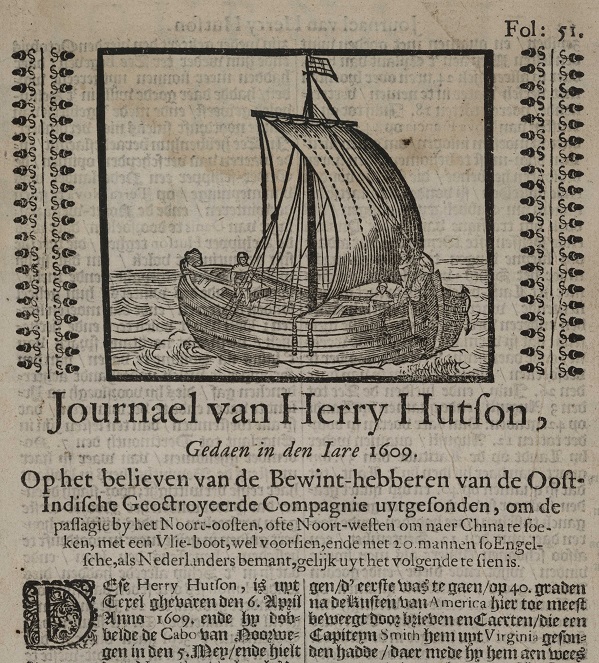North America
Beaudine Tjerks
This contribution is published in both Dutch and English. You will find the English version below.
| Nummer Koeman’s Atlantes Neerlandici, vol. II | 9310:2 |
| Titel kaart / Titel tekst | NOVA BELGICA ET ANGLIA NOVA / Nievw-Nederlandt, En Nievw-Engelandt |
De regio Noord-Amerika bestaat voor Joan Blaeu uit de gebieden Nieuw-Nederland, Nieuw-Engeland, Virginia en Bermuda. Blaeu heeft in het achtste deel van de Grooten Atlas onderscheid gemaakt tussen verschillende volkeren uit deze regio. Zo waren er volgens hem “goede” en “kwade” volkeren.
Blaeu heeft zich onder andere kunnen laten beïnvloeden door de Nederlandse en Engelse kolonisten die in dit gebied actief waren. In brieven en reisjournalen hebben kolonisten veelal hun ervaringen en beschrijvingen van de oorspronkelijke volkeren genoteerd. Een voorbeeld is de predikant Jonas Michaëlius (1577-na 1638) die naar het eiland Manhattan in Nieuw-Nederland werd uitgezonden in 1628. Michaëlius beschreef de Manhattans als wild en woest, als verduivelde mensen die niemand anders dan de duivel dienden. Ook Blaeu beschrijft het volk als een vijandelijke natie en vermeldt daarbij dat het volk zich altijd agressief heeft opgesteld tegenover de Hollanders. De ervaringen van Michaëlius kunnen dus duidelijk worden teruggelezen in de Grooten Atlas, wel is Blaeu voorzichtiger in zijn schrijfwijze. Er wordt niet over duivelaanbidders gesproken, maar mensen die vijandelijk waren tegen de Hollanders.
Geograaf en bewindhebber van de West-Indische Compagnie Johannes de Laet had toegang tot vele bronnen waarin het perspectief van de kolonisten werd overgenomen. De Laet baseert zich hierbij zowel op het reisjournaal van de Engelsman Henry Hudson als op het boek The Generall historie of Virginia, New-England, and the Summer Isles (1624). Opvallend is dat Blaeu de beschrijvingen van De Laet vaak kopieert, terwijl Blaeu ook toegang had tot andere bronnen. Blaeu had bijvoorbeeld het boek Good news from New England (1624) kunnen raadplegen, waarin Edward Winslow de gevolgen van de plaag in Nieuw-Engeland beschrijft.

Verhael van de vier eerste schip-vaerden der Hollandtsche en Zeeuwsche schepen … uytgevaren in de iaren 1594. 1595. 1596. en 1609. ende hare wonderlijcke avontueren, op de reysen voorgevallen (Amsterdam: Gillis Joosten Saeghman, 1663), p. 51
Bermuda werd, in tegenstelling tot de andere gebieden, een typische eilandkolonie zonder oorspronkelijke bewoners. Toch is ook Bermuda van belang wanneer er gekeken wordt naar de ervaringen van kolonisten in de publicatie van Blaeu. Er is sprake van toe-eigening door naamgeving van dieren, op basis van vorm en omstandigheid. Ook de aanplanting van groenten en planten werd belangrijk geacht door de kolonisten. Hoewel Blaeu niet veel aandacht besteed aan toe-eigening door naamgeving, wordt de aanplanting van gewassen wel besproken.
Blaeu was dus selectief in de informatie die hij opnam in de Grooten Atlas. Hoewel Blaeu veel informatie gekopieerd heeft uit het boek van De Laet, hebben andere kolonisten, zij het in getrapte vorm, ook gezorgd voor informatie.
Suggestie om verder te lezen:
Waterman, K.J., J. Jacobs en Ch.T. Gehring. (2009). Indianenverhalen: de vroegste beschrijvingen van Indianen langs de Hudsonrivier (1609-1680). Zutphen: Walburg Pers.
To Joan Blaeu, North America encompassed New Netherland, New England, Virginia, and Bermuda. In volume eight of his Atlas Maior, Blaeu talks about the differences between the indigenous peoples who lived in these regions, claiming that there were ‘goede’ [good] and ‘kwade’ [bad] ones.
Blaeu might well have been influenced by the Dutch and English colonists who had settled locally and wrote down their experiences with the locals in letters and travel journals. One of them was Dutch Reformed minister Jonas Michaëlius (1577-after 1638), who started serving as a clergyman on the island of Manhattan in New Netherland in 1628. Michaëlius described the Manhattans as savage and wild, and as evil people who worshipped the devil only. Blaeu too calls them a hostile nation, referring to their aggressive stance against the Dutch from the very start. Michaëlius’s experiences are clearly reflected in the Atlas Maior, although Blaeu is a little more cautious in his descriptions. He does not speak of devil worshipping, but states that the natives were hostile to the Dutch.
Geographer and director of the Dutch West India Company Johannes de Laet had access to many sources that copied the colonists’ perspective. De Laet based his writings on the travel journal of Englishman Henry Hudson as well as on Captain John Smith’s book The Generall historie of Virginia, New-England, and the Summer Isles (1624). It is interesting to note that Blaeu had a habit of copying De Laet’s descriptions, while Blaeu also had access to other sources. He could, for instance, have consulted Edward Winslow’s Good News from New England (1624), in which the author chronicles the consequences of infectious diseases in New England.
Unlike the other regions, Bermuda was uninhabited when settlers first arrived. It was a typical island colony. Bermuda is nonetheless relevant when studying the experiences of colonists in Blaeu’s publication. The settlers appropriated the island by naming animals, based on their appearance and behaviours. Settlers also deemed it important to introduce vegetables and plants from their home countries or other colonies to Bermuda. Although Blaeu does not focus much on appropriation by naming, he does discuss crop planting.
It could be argued, therefore, that Blaeu was selective in the information he decided to either include or exclude in his Atlas Maior. Blaeu copied a lot of information from De Laet’s book, but that is not to say that other colonists did not contribute any information, albeit indirectly.
Further reading:
Waterman, K.J., J. Jacobs en Ch.T. Gehring. (2009). Indianenverhalen: de vroegste beschrijvingen van Indianen langs de Hudsonrivier (1609-1680). Zutphen: Walburg Pers.
